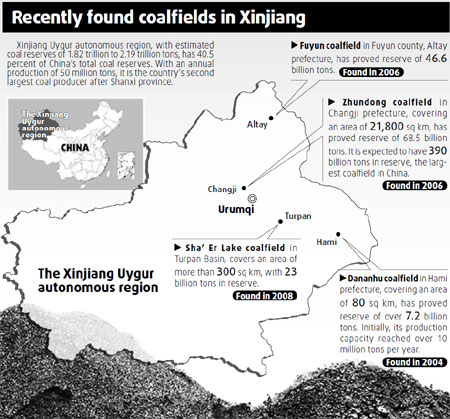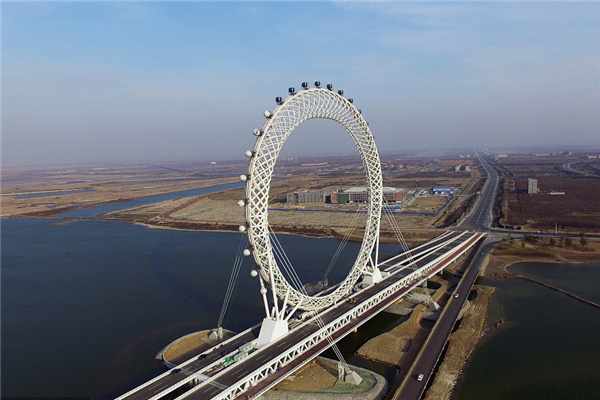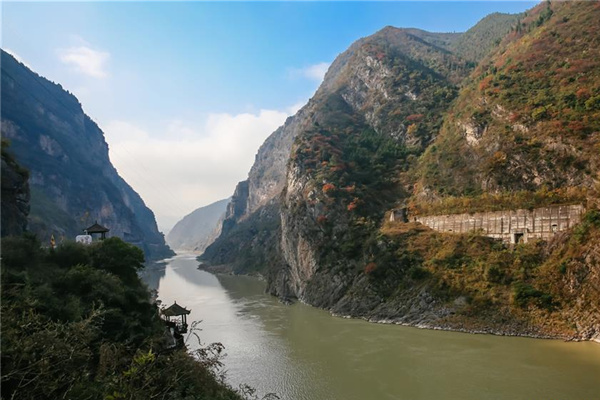


When people realized that China's coal cradle, Shanxi province, has a coal reserve that only can maintain the country's next 200-year exploitation, they started looking for its successor.
The remote Xinjiang Uygur autonomous region, which has estimated coal reserves of 1.82 trillion to 2.19 trillion tons, has become the most competitive candidate.
With soaring energy prices, Xinjiang has intensified its coal exploration,
Recently, Xinjiang revealed another mother lode when the local Department of Land and Resources announced that a coalfield with 23 billion tons in reserve was discovered.
The Sha'Er Lake coalfield, about 800 m underground, covers an area of more than 300 sq km in Shanshan county in the Turpan Basin.
Its reserve is equal to ten times China's current annual coal demand, which is expected to exceed 3 billion tons by 2010.
Jiang Bing, an official from the National Energy Administration, also says the 23 billion ton reserve of the Sha'Er Lake coalfield is just part of the total reserve of the coalfield. He predicted the total reserve would be 100 billion to 200 billion tons.
Shanshan county has a proven reserve of 10 billion tons, and it's expected to exceed 64.4 billion tons.
Party secretary of Shanshan county, Zhao Wenquan, says the government of Xinjiang Uygur autonomous region has put Shanshan on the list of key regions for coal exploration while they work out plans for its layout, exploration and exploitation.
Xinjiang, with estimated coal reserves of 1.82 trillion to 2.19 trillion tons, accounts for 40.5 percent of China's total coal reserves. With an annual production of 50 million tons, it is the country's second largest coal producer after Shanxi province.
It is planning to have an annual coal production capacity of 1 billion tons by 2020, accounting for over 20 percent of China's annual coal production.
Xinjiang is also striving to develop four huge coal bases in Zhundong (Eastern Junggar Basin), Turpan-Hami, Yili, and Kuche-Baicheng coalfields.
An official with Department of Land and Resources of Xinjiang Uygur autonomous region says that by 2010, Xinjiang will produce over 100 million tons of coal.
He says as the coal reserve in eastern China has begun declining dramatically, Xinjiang has become next important base for strategic energy.
He adds that with the increase of exploitation, coal in Xinjiang will be transported like natural gas to satisfy the energy demands of eastern China.
But, Yao Guoping, an official from the Coal Industry Administrative Bureau of Turpan, says it's too early to estimate the impact of the Sha'Er Lake coalfield on the region's total coal production capacity and energy reserves, because the exploration of the coalfield depends on the country's pace of economic development and its overall energy demands.
Because of the US financial crisis and falling oil prices, there is a question whether China can maintain its high pace of economic development, and meet its energy demands.
Due to the global economic downturn and dwindling domestic demand, coal prices at Qinhuangdao port, China's largest coal port, dropped by 25 percent over the past two weeks and coal stockpiles have risen to a record 9 million tons.
Analysts and traders are now warning producers to cut production so that the coal surplus does not drive prices down further.
According to Huang Shengchu, president of the Beijing-based China Coal Information Institute, with the impact of the financial crisis looming larger in China, the coal producers can only count on the government's 4-trillion-yuan economic stimulus plan to initiate more infrastructure projects, which will boost steel and electricity demands.
However, an official with Department of Land and Resources of Xinjiang Uygur autonomous region, tells China Business Weekly that in the short term, Xinjiang would be a strategic energy base rather than a huge energy producer.
He says Xinjiang has been preparing for rebound of the country's energy demand.
Zhang Handong, an official with a local department that is in charge of coal exploration, says the production potential of Xinjiang's unexplored coalfields is too large to estimate.
Zhang says Xinjiang coal exploration is in a primary stage because the cost of long-distance transport remains high.
The Sha'Er coalfield, rich in low-sulfur steam coal, is close to the Lanzhou-Xinjiang railway, the only rail line connecting Xinjiang to the inland cities. It is also 800 km nearer to China's inland than the region's largest Zhundong coal production base, which could cut the transportation cost by 40 yuan per ton.
Zhang says Xinjiang is currently focusing on coal chemical processing and coal-electricity joint operations.
In recent years, the energy and mineral resource potential of Xinjiang has sparked the interest of related enterprises.
As of 2007 more than 20 domestic and foreign companies entered the region to prospect and develop mineral resources, such as China Shenhua, Luneng and Baosteel group, and the investment in the coal industry leapt to 100 billion yuan.
State Grid signed agreements with Changji prefecture government this July to invest in coal chemical and coal-electricity projects in Zhundong (Eastern Junggar Basin) coalfield.
During the 11th Five Year Plan (2006-2010), Shenhua is planning to invest 8.4 billion yuan in coal-power integration, coal chemical and coal-to-liquid projects in Zhundong.
In 2007, Shandong Xinwen Mining Group invested 2.5 billion yuan in a coal chemical project in Yili prefecture, which is expected to completed next year.
The project will generate an annual production capacity of 10 million tons with annual revenue of over 1.4 billion yuan.
And Shandong Luneng Group has initiated a 3 million ton coal and power project in Hami prefecture.
Transport
Transport, the problem that slows the development of Xinjiang's coal industry, has been increasingly improved.
Recently, the Chinese government announced it would spend 120 billion yuan to build a second railway traversing the northwestern Xinjiang Uygur autonomous region, and construction is expected to begin next year.
The railway will go through Gansu, Qinghai and Xinjiang. It will facilitate the transport of agricultural products and minerals, mainly coal, out of Xinjiang, by relieving congestion on the existing line.
The railway construction from Xinjiang capital Urumqi to Junggar-Eastern began in November 2007. The eastern part of the Junggar Basin holds up to 370 billion tons of coal reserves. It serves as the main coal base of the coal electricity and coal chemical industry in Xinjiang.
Gao Juanjun, an official of Xinjiang Uygur autonomous region government in charge of coal-power and coal chemical projects, says there will be more large-scale projects in the near future.
(China Daily 12/01/2008 page4)













